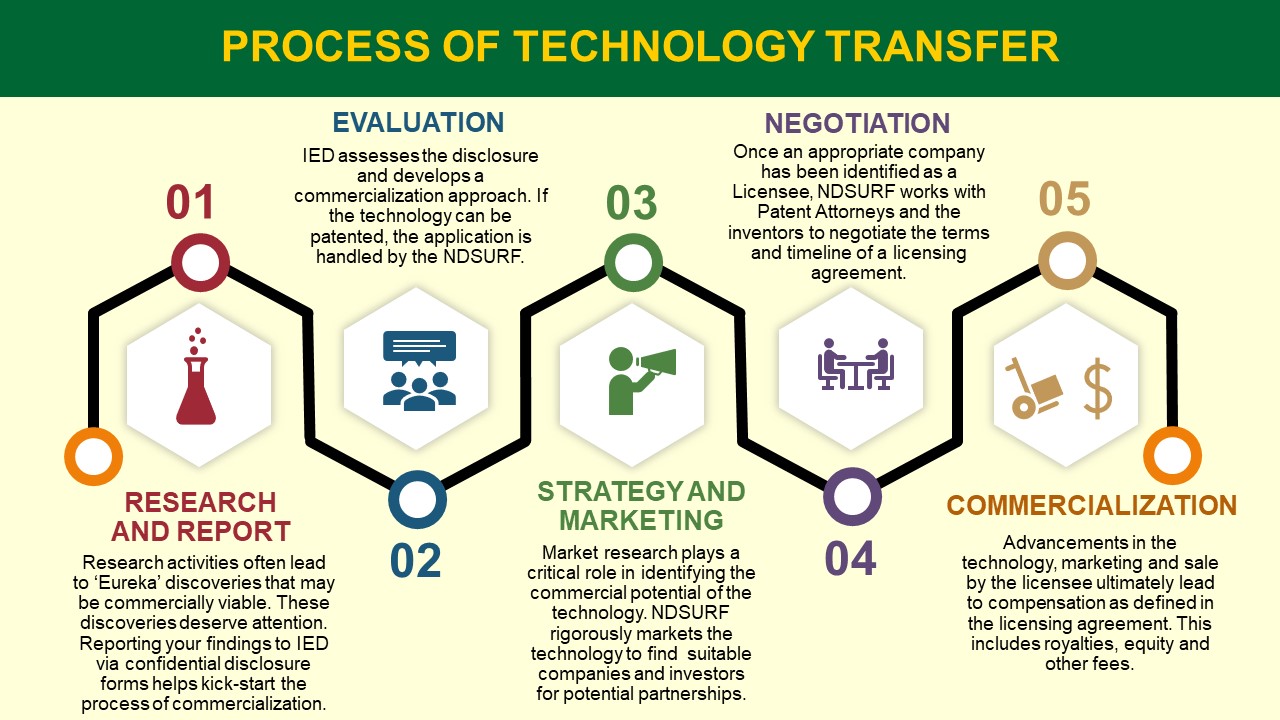For Inventors
Faculty, Staff, & Students
NDSU faculty, staff, and students (consistent with NDSU Policy 190 (PDF)) must report their novel scientific discoveries as invention disclosures to the Research Foundation reviews the inventions and upon completion of patentability evaluation, the disclosure may be assigned to the NDSU Research Foundation for IP protection, marketing, and licensing. Inventors are encouraged to review NDSU Policy 190.
Technology Transfer Process Overview
The key events in the development, protection and commercialization of an invention are listed below. The list depicts the order in which these events typically occur; however, some events may occur simultaneously or in a different order, depending on the needs of the inventors and the university.
- NDSU researcher(s) pursues an academic or sponsored research question. Prior to the actual creation of an invention or in the early stages of reducing the invention to practice, a researcher may require the assistance of the NDSU Research Foundation in preserving intellectual property (IP) rights and, helping maintain the confidentiality of the research in its proposal and development stages.
- The researcher makes a novel discovery and reports the invention by submitting an Invention Reporting form to the Research Foundation. For software, there is a Software Reporting form, while plant breeders should use the Plant Variety Report form or Horticultural Variety Reporting form. All reporting forms are to be submitted to the NDSU Research Foundation Office.
- The Research Foundation Office initially evaluates the reported invention for commercial potential and patent, copyright, trademark, or plant variety protection. This process often involves in-depth discussions with the inventor.
- Inventor(s) assigns the invention to NDSU. NDSU then assigns the invention to the NDSU Research Foundation (NDSURF) in order to pursue IP protection and commercialization of the invention.
- NDSURF may file for a patent or other intellectual property protection, initially paying all the associated attorney fees and costs of protecting the invention. Proper protection includes geographic considerations, inventorship, and clear delineation of claims from any “ prior art” and literature.
- NDSURF continues to explore the commercial marketplace and assesses commercial value, marketability, intellectual property protection, and the potential for further development.
- NDSURF takes the final step in the process, initiating one of four options:
- Licenses invention to an outside commercial entity.
- Requests that the inventor complete additional research before pursuing further commercialization activities.
- Licenses the invention to a faculty member’s start-up company.
- Releases or returns the invention to the government or inventor, according to NDSU policy and any applicable contractual or governmental obligations.

Download a copy of the process (PDF, 79.71 KB)
Reporting Forms & Additional Information
You can find reporting forms and additional information on the NDSU website.